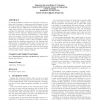Free Online Productivity Tools
i2Speak
i2Symbol
i2OCR
iTex2Img
iWeb2Print
iWeb2Shot
i2Type
iPdf2Split
iPdf2Merge
i2Bopomofo
i2Arabic
i2Style
i2Image
i2PDF
iLatex2Rtf
Sci2ools
WWW
2006
ACM
2006
ACM
Detecting semantic cloaking on the web
By supplying different versions of a web page to search engines and to browsers, a content provider attempts to cloak the real content from the view of the search engine. Semantic cloaking refers to differences in meaning between pages which have the effect of deceiving search engine ranking algorithms. In this paper, we propose an automated two-step method to detect semantic cloaking pages based on different copies of the same page downloaded by a web crawler and a web browser. The first step is a filtering step, which generates a candidate list of semantic cloaking pages. In the second step, a classifier is used to detect semantic cloaking pages from the candidates generated by the filtering step. Experiments on manually labeled data sets show that we can generate a classifier with a precision of 93% and a recall of 85%. We apply our approach to links from the dmoz Open Directory Project and estimate that more than 50,000 of these pages employ semantic cloaking. Categories and Subje...
Internet Technology | Search Engine | Semantic Cloaking Pages | Semantic Cloaking Refers | WWW 2006 |
Related Content
| Added | 22 Nov 2009 |
| Updated | 22 Nov 2009 |
| Type | Conference |
| Year | 2006 |
| Where | WWW |
| Authors | Baoning Wu, Brian D. Davison |
Comments (0)

